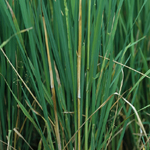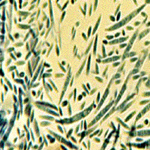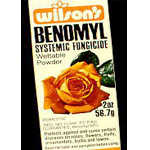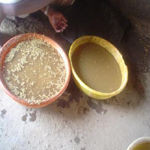|
Bakanae Disease or Foot Rot
(Gibberella Fujikuroi)
| Symptoms |
|
| |
|
- Infected plants several inches taller than normal plants in seedbed and field
- Thin plants with yellowish green leaves and pale green flag leaves
- Drying seedlings at early tillering
- Reduced tillering and drying leaves at late infection
- Partially filled grains, sterile, or empty grains for surviving plant at maturity
- In the seedbed, infected seedlings with lesions on roots die which may die before or after transplanting
|
 |
-SPL.jpg) |
| Bakane |
Bakanae Disease
(Gibberella Fujikuroi) |
|
| Top |
| |
Identification of pathogen |
|
|
 |
 |
- The pathogen sexually produces ascospores that are formed within a sac known as ascus.
- The asci are cylindrical, piston-shaped, flattened above, and are 90-102 x 7-9 µm. They are 4- to 6-spored but seldom 8-spored.
- Hyphae are branched and septate. The fungus has micro- and macroconidiophores bearing micro- and macroconidia, respectively.
- The sclerotia are 80 x 100 µm. They are dark blue and spherical. The stroma are more or less plectenchymatous and yellowish, brownish, or violet.
|
Gibberella Fujikorai
Conidium |
Micro and Macro
Conidia of Bakane
Disease |
|
| Top |
| Management Strategies |
|
|
|
- Clean seeds should be used to minimize the occurrence of the disease.
- Salt water can be used to separate lightweight, infected seeds from seed lots and thereby reduce seedborne inoculum.
- Seed treatment using fungicides such as thiram, thiophanate-methyl, or benomyl is effective before planting.
- Benomyl or benomyl-t at 1-2% of seed weight should be used for dry seed coating.
- Seed treatment with organo mercurials - Agrosan GN, Ceresan @ 2 g a.i./kg seed is highly effective; steeping seeds in 1% CuSO4 solution or 2% formalin also recommended.
|
 |
 |
| Benomyl |
Separation of Chaffy Seeds using Salt Water |
| Top |
|

-SPL.jpg)




